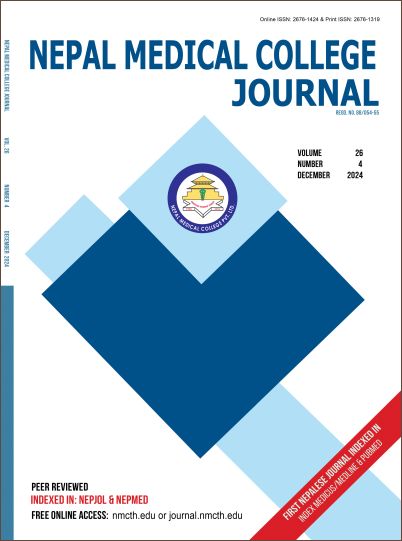Indications, Diagnostic yield and Appropriateness of Gastrointestinal Endoscopic Procedures in Children: Experience of a Tertiary Level Teaching Hospital of Nepal
DOI:
https://doi.org/10.3126/nmcj.v26i4.74455Keywords:
Endoscopy, diagnostic yield, pediatrics, NepalAbstract
Gastrointestinal (GI) endoscopy has been a key diagnostic tool from the past in adult patients, but its usefulness has been increasing in pediatric cases also. With development of technologies, these procedures have been relatively safer than in the past and have increased the yield in the diagnosis of GI diseases. Nepal being a developing country, it still has lesser pediatric GI cases and the outcomes of such cases are also limited. This retrospective study aimed to assess the types of GI procedures done along with their indications and diagnostic yields of these procedures which were conducted by reviewing data of all the patients between the ages of 0-18 years who underwent endoscopy in our center from January 2018 to December 2022. Overall, 82% of the 323 procedures performed in 268 patients during this study period (mean age 10 years) had a positive endoscopic finding, among which gastritis/duodenitis was the commonest (32.1%). Most common indication for the endoscopic procedures was pain abdomen (28%) followed by vomiting (25.7%). Rectal bleeding (24.3%) was the most common indication for doing lower GI procedures. Based on ESGE and ESPGHAN guidelines, 98.15% of the procedures done were considered appropriate. Histopathologically 27 out of 65 (41.5%) cases had Helicobacter pylori positive gastritis while 28 (43.0%) had no abnormalities detected. No major procedural and post procedure complications were noted in any of the study children indicating safety of such GI procedures under proper sedation. General practitioners and pediatricians should be encouraged to refer such children for the diagnosis and proper management as there procedures have been accessible and considered safe nowadays.
Downloads
Downloads
Published
How to Cite
Issue
Section
License
Copyright (c) 2024 Nepal Medical College Journal

This work is licensed under a Creative Commons Attribution 4.0 International License.
This license enables reusers to distribute, remix, adapt, and build upon the material in any medium or format, so long as attribution is given to the creator. The license allows for commercial use.




